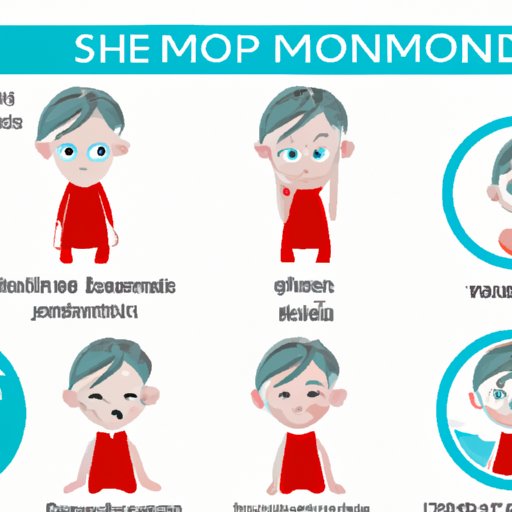
Introduction
Mononucleosis (mono) is a common viral illness that affects people of all ages. Knowing how long it takes for mono symptoms to show is crucial for seeking appropriate treatment and avoiding the spread of the illness. In this article, we’ll explore the timeline of mono symptoms, common misunderstandings, and tips for managing the illness.
Overview of Mono Symptoms and Signs
Mono symptoms can vary widely, but common ones include fever, sore throat, fatigue, swollen lymph nodes, and enlarged spleen. It typically takes 4-6 weeks after exposure to the virus for symptoms to appear. The initial signs of mono can feel similar to the flu, such as fever, headache, and body aches. The sore throat can appear within a few days and is often severe. It can be accompanied by white patches or pus on the tonsils. The fatigue can last for several weeks and even months after the other symptoms have subsided. The swollen lymph nodes can appear in the neck, armpits, and groin areas.
Timeline of Mono Symptoms
Within the first two weeks of exposure to the virus, fatigue, fever, and sore throat can appear. The enlarged lymph nodes can occur within the first month. Enlarged spleen, skin rash, and jaundice tend to appear several weeks after the onset of the illness. The symptoms can last anywhere from a few weeks to several months. However, each person may experience a different timeline of symptoms, making it difficult to pinpoint the exact duration of the illness.
Common Misunderstandings About Mono Symptoms
One of the most common misunderstandings about mono is that it only affects teenagers or young adults. However, people of all ages can contract the illness. Another misconception is that mono always causes a fever. While fever is a common symptom, not everyone with mono will have a fever. Additionally, mono is often mistaken for strep throat or other illnesses due to similar symptoms, but it is important to receive a proper diagnosis from a healthcare professional.
Tips for Managing Mono Symptoms
Unfortunately, there is no cure for mono, but there are ways to manage the symptoms. Over-the-counter pain relievers, such as acetaminophen or ibuprofen, can help alleviate fever, sore throat, and body aches. Drinking fluids and getting plenty of rest is also essential. Avoiding contact sports or other strenuous activities is important to prevent spleen rupture, which can be a serious complication of mono. It’s also important to avoid alcohol to protect the liver, which can be affected by mono.
How Long Does It Take for Mono to Clear Up?
The typical duration of mono is 4-6 weeks, although some people may experience lingering symptoms for several months. However, it can take up to a year for the fatigue to completely resolve. If symptoms persist or worsen, it’s important to seek medical attention. In rare cases, mono can cause other complications such as anemia, meningitis, or encephalitis.
If You’re Exposed to Someone with Mono
The incubation period for mono is typically 4-6 weeks after exposure to the virus. If you’ve been exposed to someone with mono, it’s important to take precautions to avoid contracting the illness or spreading it to others. Wash your hands frequently with soap and water and avoid sharing drinks or utensils with the infected person. If you start to experience symptoms, seek medical attention promptly.
Mono Symptoms in Children
Mono can affect children as well. However, the symptoms may be less severe than in teens and adults. Common symptoms in children include fever, sore throat, and swollen lymph nodes. It typically takes 4-6 weeks for symptoms to show up in children. Rest and hydration are important for managing the illness in children, as well as keeping them at home to prevent the spread of the virus to others.
Conclusion
Knowing how long it takes for mono symptoms to show is essential for seeking treatment and preventing the spread of the illness. Understanding the timeline of symptoms, common myths and misconceptions, and tips for managing the illness can help individuals who are dealing with the illness or have been exposed to it. If you suspect that you or a loved one may have mono, seek medical attention promptly.





